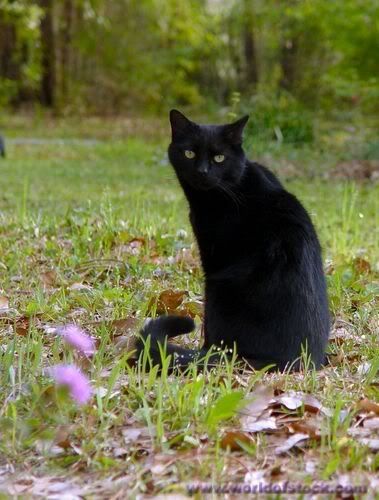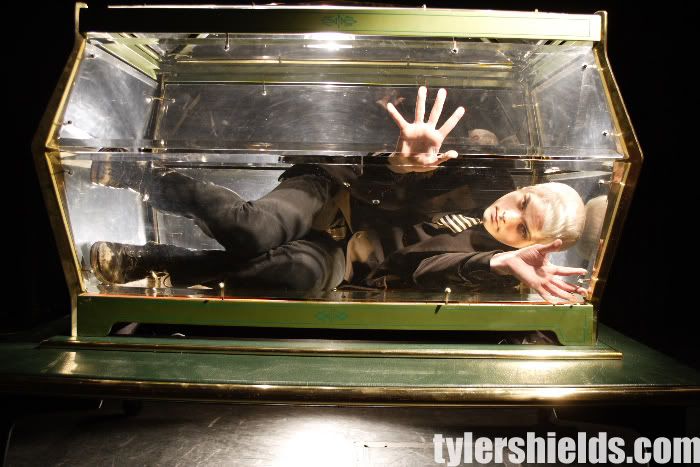Dec 26, 2007
SO stuffs
- Frequency is a measure of the number of occurrences of a repeating event per unit time.
- The period of a wave is the time the full wave takes to pass a given point
- Longitudinal waves are waves that have vibrations along or parallel to their direction of travel; that is, waves in which the motion of the medium is in the same direction as the motion of the wave.
- A standing wave, also known as a stationary wave, is a wave that remains in a constant position
- Refraction is the change in direction of a wave due to a change in its speed.This is most commonly seen when a wave passes from one medium to another. Refraction of light is the most commonly seen example, but any type of wave can refract when it interacts with a medium.
- Reflection is the change in direction of a wave front at an interface between two different media so that the wave front returns into the medium from which it originated. Common examples include the reflection of light, sound and water waves.
- Diffraction refers to various phenomena associated with the bending of waves when they interact with obstacles in their path. It occurs with any type of wave, including sound waves, water waves, and electromagnetic waves such as visible light, x-rays and radio waves
- Primary light colors: Violet, blue, green, yellow, orange , red
- The electromagnetic spectrum is the range of all possible electromagnetic radiation. The "electromagnetic spectrum" (usually just spectrum) of an object is the characteristic distribution of electromagnetic radiation from that object.
The electromagnetic spectrum, extends from below the frequencies used for modern radio (at the long-wavelength end) through gamma radiation (at the short-wavelength end), covering wavelengths from thousands of kilometers down to a fraction the size of an atom. In our universe the short wavelength limit is likely to be in the vicinity of the Planck length, and the long wavelength limit is the size of the universe itself (see physical cosmology), though in principle the spectrum is infinite and continuous.
- The Doppler effect is the change in frequency and wavelength of a wave as perceived by an observer moving relative to the source of the waves. For waves that propagate in a wave medium, such as sound waves, the velocity of the observer and of the source are relative to the medium in which the waves are transmitted. The total Doppler effect may therefore result from motion of the source or motion of the observer or motion of the medium. Each of these effects is analyzed separately. For waves which do not require a medium, such as light or gravity in special relativity, only the relative difference in velocity between the observer and the source needs to be considered.
- In physics, wavelength is the distance between repeating units of a propagating wave of a given frequency. It is commonly designated by the Greek letter lambda (λ). Examples of wave-like phenomena are light, water waves, and sound waves.
Wavelength λ is inverse proportional with the frequency, the number of wave periods per time unit passing a given point, as in
where vw is the propagation velocity of the wave. In the case of electromagnetic radiation, such as light, in a vacuum, this speed is the speed of light, 299,792,458 m/s or about 3x108 m/s. For sound waves in air, this is the speed of sound, 344 m/s (1238 km/h) in air at room temperature. Usually, SI units are used, where the wavelength is expressed in meters, the frequency in Hz, and the propagation velocity in meters per second.
- A transverse wave is a traveling wave, a wave that propagates (travels) in a direction perpendicular to the direction in which the oscillations that produce the wave are moving. For example: if a transverse wave is moving in the positive x-direction, its up and down oscillations are in up and down directions that lie in the yz-plane.
Light is composed of transverse waves. See electromagnetic spectrum for information on different types of electromagnetic waves. Electromagnetic waves are transverse waves.
- Electromagnetic radiation is a self-propagating wave in space with electric and magnetic components.
- Wave propagation is any of the ways in which waves travel through a medium.
- A waveguide is a structure which guides waves, such as electromagnetic waves, light, or sound waves. There are different types of waveguide for each type of wave.
- An element's emission spectrum is the relative intensity of electromagnetic radiation of each frequency it emits when it is heated (or more generally when it is excited).
When the electrons in the element are excited, they jump to higher energy levels. As the electrons fall back down, and leave the excited state, energy is re-emitted, the wavelength of which refers to the discrete lines of the emission spectrum. Note however that the emission extends over a range of frequencies, an effect called spectral line broadening.
The emission spectrum can be used to determine the composition of a material, since it is different for each element of the periodic table. One example is identifying the composition of stars by analyzing the received light.
An absorption spectrum occurs when light passes through a cold, dilute gas and atoms in the gas absorb at characteristic frequencies; since the re-emitted light is unlikely to be emitted in the same direction as the absorbed photon, this gives rise to dark lines (absence of light) in the spectrum. The light emitted from an excited atom can not be directed toward the observer, so the light appears to be missing from the continuous spectrum.
- A material's absorption spectrum shows the fraction of incident electromagnetic radiation absorbed by the material over a range of frequencies. An absorption spectrum is, in a sense, the opposite of an emission spectrum.
Every chemical element has absorption lines at several particular wavelengths corresponding to the differences between the energy levels of its atomic orbitals. For example, an object that absorbs blue, green and yellow light will appear red when viewed under white light. Absorption spectra can therefore be used to identify elements present in a gas or liquid. This method is used in deducing the presence of elements in stars and other gaseous objects which cannot be measured directly.
- Interference is the addition (superposition) of two or more waves that results in a new wave pattern.
As most commonly used, the term interference usually refers to the interaction of waves which are correlated or coherent with each other, either because they come from the same source or because they have the same or nearly the same frequency.
- Consider two waves that are in phase,with amplitudes A1 and A2. Their troughs and peaks line up and the resultant wave will have amplitude A = A1 + A2. This is known as constructive interference.
- If the two waves are pi radians, or 180°, out of phase, then one wave's crests will coincide with another wave's troughs and so will tend to cancel out. The resultant amplitude is A = | A1 − A2 | . If A1 = A2, the resultant amplitude will be zero. This is known as destructive interference.
- Radio waves are electromagnetic waves occurring on the radio frequency portion of the electromagnetic spectrum. A common use is to transport information through the atmosphere or outer space without wires. Radio waves are distinguished from other kinds of electromagnetic waves by their wavelength, a relatively long wavelength in the electromagnetic spectrum.
- In most of the world, the FM broadcast band, used for broadcasting FM radio stations, goes from 87.5 to 108.0 MHz.
- In telecommunications, frequency modulation (FM) conveys information over a carrier wave by varying its frequency (contrast this with amplitude modulation, in which the amplitude of the carrier is varied while its frequency remains constant)
- Amplitude modulation (AM) is a technique used in electronic communication, most commonly for transmitting information via a radio carrier wave. AM works by varying the strength of the transmitted signal in relation to the information being sent. For example, changes in the signal strength can be used to reflect the sounds to be reproduced by a speaker, or to specify the light intensity of television pixels.
Dec 25, 2007
Dec 24, 2007
Hey, it's almost Christmas!
And even though I am a lapsed Catholic, it does not mean I have given up on what the rest of my family does around this time of the year.
In fact, for the past week, I've been baking. Baking pundcake and cookies! I've also been glued to the internet all day along, more or less.
And today, I went to the grocery store with my mother and was motivated to take this picture:

Yes, that is a cooked and cut octopus. I wonder if anyone has bought an octopus from a Savemart, or if it's the only one they have and it never gets sold.
A person may never know.
And it's a slightly gruesome sight if you ask me.
Dec 21, 2007
My boyfriend via email said....
My reply to this:
"WANT. WANT. WANT WANT WANT WANT WANT WANT.
MARRY ME, I WANT TO GET TO YOUR COLLECTIBLES."
Seriously.
 But if he doesn't have his Harley and Ivy figures next to each other, then there will be hell to pay.
But if he doesn't have his Harley and Ivy figures next to each other, then there will be hell to pay.They're lesbian for each other! Duh!
Dec 18, 2007
Ok, book report over
Dec 13, 2007
The Fall of the House of Usher
Roderick then tells Dave days later that his sister had died, and that she needs to be put in a tomb in the basement of the house before she's buried for good. After this, Roderick's demeanor changes greatly, he becomes withdrawn into himself and he becomes extremely aggrivated. One night, a horrible storm starts and Dave cannot get himself to sleep. Roderick comes into Dave's room and throws open the window. Dave attempts to get Roderick sane and manageable by reading him The Mad Trist. As Dave reads the story, he could hear faint noises that correspong with what's happening in the story. He comes close to Roderick because he's murmuring something. Roderick says "Not hear it? -- yes, I hear it, and have heard it...I dared not speak! We have put her living in the tomb!...-- say, rather, the rending of her coffin, and the grating pf the iron hinges of her prison, and her struggles in the copper archway of the vault!...Is she not going to upbraid me for my haste? Have I not heard her footstep on the stair?...Madman! I tell you that she now stands without the door!"
Roderick knew that Madeline was not dead at the time, but he never bothered to tell Dave because Dave is rational and wouldn't allow her being entombed. The door to Dave's room opens and there stands Madeline, on the border of death, and blood on her clothing from her struggle to get back to her brother. Madeline comes forward and throws herself onto Roderick, both of them dying that moment. Dave runs for it, and once he is away from the house, the house breaks into pieces and falls into the ground.
Personal reaction: I love how this story ended. With the unexpected return of Madeline, her bloody clothing, the mental image of her with bloody hands, disheveled hair, and angry with a bloodlust in her eyes. Dave not knowing what the heck is going on, the correspondence with the story he read. Roderick and his family and their mental problems, these elements create such an interest into a story only a few pages long.

Dec 8, 2007
Of the stories so far...
I'm being honest, Dupin simply wasted his fictional breath by giving a long story to a simple question. Also, there was no murder in "The Puroined Letter", but Bill killed his wife in "The Back Cat". I think Bill had more fun. (:P)
Dec 7, 2007
The Purloined Letter

Dupin questioned the police captain about the letter and how it was searched for. G-- (the captain) had said that the police unit had searched every possible hiding place for a letter. Dupin was content with this information and so G-- left. G-- returns to Dupin and his friend sometime later, with the letter still missing. Dupin asks whether the police has had any leads on the letter, G-- tells that they've haven't, and that he was willing to give up 50,000 Francs from the reward to any sort of lead. Dupin says that G-- should write the check because he on his own had found and retrieved it. G-- was shocked and when Dupin had handed over the letter and it was the letter the police had searched hard for.
G-- leaves, and Dupin reveals to his friend/the narrator how exactly he had found it. (It's a rather long winded explination, and I wanted to just skip some pages and get to the point.) He said he had disguised himself and went to Minister D's home and had located where it was there. Dupin went back a second time, had paid a man to cause a major distraction outside so Dupin could get he letter and secure it. His plan had worked and he got 50,000 Francs for his clever deduction.
Point of View: The narration of this story was a first person limited p.o.v. The reader found out details when the narrator himself found out details. He had no prior knowledge to any of the happenings until either G-- or Dupin had told him what had gone on.
Dec 6, 2007
The Black Cat

Bill moves into a temporary new house, which I believed to be a cellar, and he starts to miss his beloved Pluto. Bill is still addicted to alcohol, so one night, while at a tavern, he spots a cat very similar to Pluto and takes the cat with him. The only difference between Pluto and this new cat, is that Pluto was a rich, solid black, but the new cat has a big white spot on its chest. He soon realizes that the cat's white spot is in the shape of the gallows. Bill's affection for his new cat soon turns to hatred, and he despises the thing. One day, Bill and his wife are down in the cellar, and the cat trips Bill and nearly kills him. In a rage, Bill gets an axe and attempts to kill the cat, but his wife stops him before he is able to. So instead of killing the cat, Bill swings the axe into his wife's head. The cat has run away, so Bill has the task of hiding is wife's corpse. He pulls apart one of the walls in the cellar and stuffs her dead body in the hole. After a few days, the police come unexpectedly to search the house, and everything looks fine, so they do not charge Bill of any crimes. As the police are leaving Bill says goodbye, and goes to knock on the wall where the corpse is, and an unearthly howl starts and Bill backs off, in terror, to the opposite wall. The police are instantly aware that their search is not finished so they take apart the wall, and there is Bill's wife's corpse and the cat perched on her head howling with it's one eye and mouth wide open. Bill is sentenced to hang on the gallows.
Characterization: Bill was sane in the start of the story, but his alcohol addiction led to him becoming irrational towards his various pets, and Pluto was no exception. The morning after Bill had carved Pluto's eye out, I saw that he was more sane and rational in is thinking. When the new cat is introduced, Bill takes an immediate liking to it. For some unknown reason, the cat instills a hate in Bill that he cannot be in the same room with the cat. I never fully understood why Bill had hated the cat so much, but I suspect that it has to do with it's similarity to Pluto. Also, Bill's irrational hatred for the new cat led him to kill his wife by putting an axe in her head, when all she did was stop him from killing the cat. In the end, I think that Bill had snapped and that he got what was coming to him
Nov 30, 2007
An Overview
 Edgar Allan Poe. Born 1809, died 1849, and a literary author of many poems and short stories, including The Raven, The Fall of the House of Usher, The Narrative of A. Gordon Pym, and many more.
Edgar Allan Poe. Born 1809, died 1849, and a literary author of many poems and short stories, including The Raven, The Fall of the House of Usher, The Narrative of A. Gordon Pym, and many more. His works were published between 1824 up until the year of his death. Various themes of his works including suspense and mystery. Not all of his works were creepy and scary as most believe, but they do require a sense of cynicism. The setting of his stories differ from tale to tale.
This blog, currently, is dedicated to a handful of his works and my thoughts on them.















